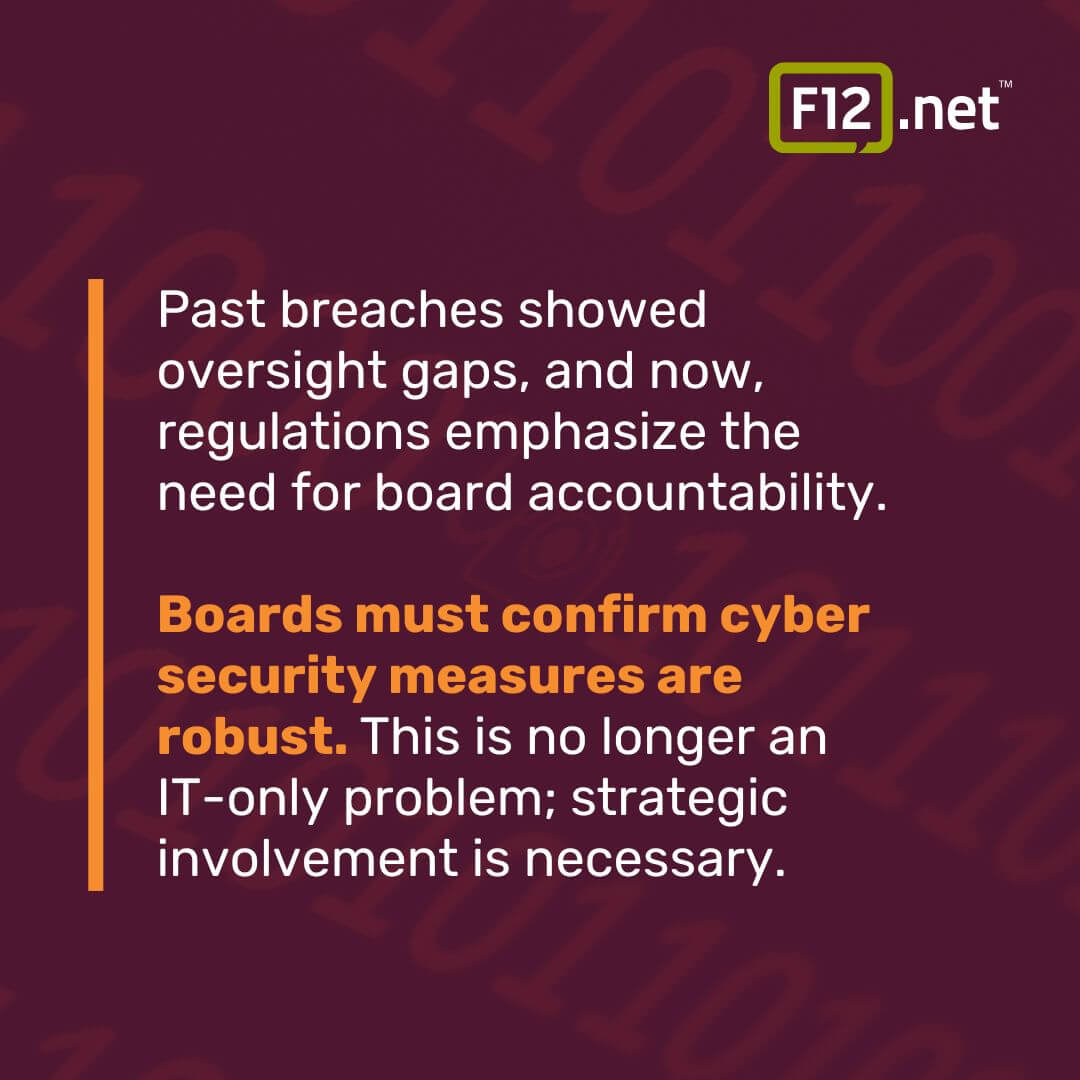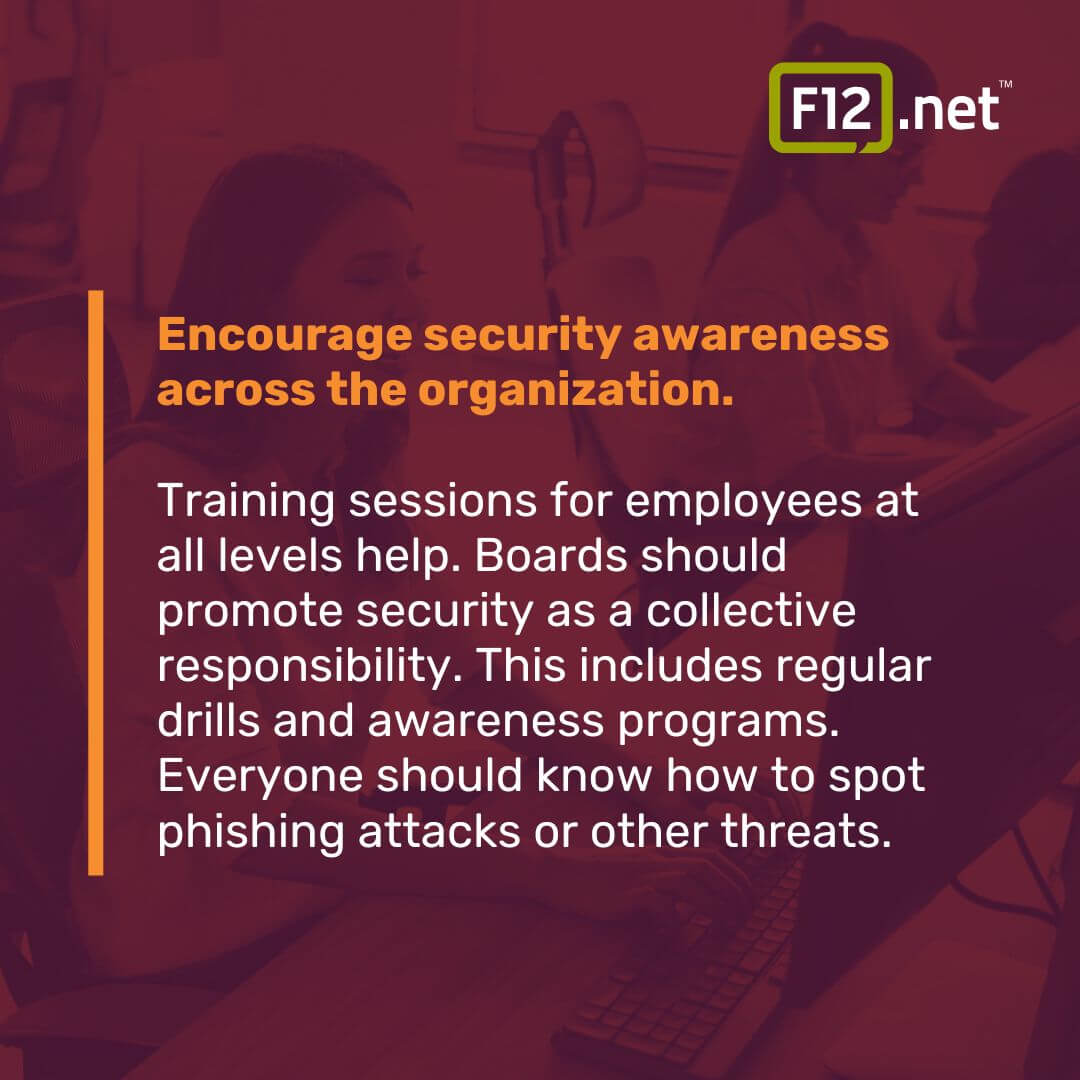Is Your Board Prepared for New Cyber Security Regulations?
“At best we gain a few months before the next crisis without any real change at the level of governance. At worst, we are heading towards something …worse.” – Jean Claude
In 2024, cyber security is becoming a boardroom battleground.
Imagine this: You’re sitting in a high-rise conference room, the city skyline sprawling behind you.
The air is thick with tension.
Your fellow board members shift uneasily in their chairs.
The CEO’s face is grim as she delivers the news: “We’ve been hacked. Customer data is compromised. And the regulators are breathing down our necks.”
This isn’t a dystopian fiction.
It’s a very real scenario playing out in boardrooms across the globe.
The stakes?
Astronomical.
We’re talking millions in fines, shattered reputations, and careers hanging by a thread.
Here’s the kicker: Most boards are woefully unprepared for the cyber security storm that’s brewing.
Are you ready to face the music when (not if) a breach occurs?
Can you confidently say your board is up to speed on the latest regulations?
Or are you secretly crossing your fingers, hoping it won’t happen on your watch?
Let’s cut through the jargon and fear-mongering.
This guide is your resource for knowledge and strategies to turn cyber security from a looming threat into a competitive advantage.
By the time you finish reading, you’ll have a clear roadmap for navigating the complex world of cyber security governance. You’ll know exactly what steps to take to protect your organization, your shareholders, and yes, your own reputation.
The clock is ticking.
Are you ready to step up and lead?
Understanding New Cyber Security Regulations
Overview of Key Changes
The cyber security environment is tightening.
Recent regulatory developments are reshaping how organizations must approach data protection and cyber risk management.
Notably, the European Union’s NIS2 Directive and the United States Securities and Exchange Commission’s (SEC) cyber security rules are setting higher standards for compliance.
These regulations mandate increased accountability at the board level for data breaches and introduce steeper penalties for non-compliance.
With key deadlines on the horizon, businesses worldwide are under pressure to enhance their cyber security measures promptly.
Why Compliance Matters for Boards
Boards should brace for significant changes. The financial risks of non-compliance are huge. Fines can now run into millions, especially if negligence is proved. Legal liabilities are stricter, prompting senior executives to ensure comprehensive compliance.
Reputation is crucial to keeping your business afloat, and data breaches tarnish brands. Consumers lose trust, and competitors gain an edge. For boards, safeguarding digital assets isn’t just technical but strategic. Public confidence elevates or damages corporate standing swiftly.
Past breaches showed oversight gaps, and now, regulations emphasize the need for board accountability. Boards must confirm cyber security measures are robust. This is no longer an IT-only problem; strategic involvement is necessary.

Immediate Actions for Boards
Evaluate Current Cyber Security Posture
First, boards should assess their cyber security posture. Review existing policies and ask critical questions: Are current measures adequate? Are there gaps in data protection? This assessment builds a foundation for compliance.
Schedule a Compliance Audit
A compliance audit is next. Auditors help identify gaps and suggest improvements. These audits should be scheduled immediately. Early audits can spot issues well before deadlines.
Invest in Monitoring Tools
Now’s the time to use monitoring tools. Tools like SIEM (Security Information and Event Management) offer real-time insights into potential threats. They track and report incidents, ensuring regulatory standards are met. Consider solutions like Splunk or Rapid7 for robust monitoring.
Foster a Culture of Security

Encourage security awareness across the organization. Training sessions for employees at all levels help. Boards should promote security as a collective responsibility. This includes regular drills and awareness programs. Everyone should know how to spot phishing attacks or other threats.
Set Clear Compliance Responsibilities
Clarify everyone’s roles in maintaining cyber security. From IT to top executives, assign duties. Align these responsibilities with broader business strategies. Assign a Chief Information Security Officer (CISO) if you haven’t. The CISO is crucial for guiding strategies and communicating risks.
Board Responsibilities for Cyber Security Compliance
Establishing a Governance Framework
A board plays a vital role in defining cyber security policies. They need to establish clear guidelines and responsibilities that fit within an organization’s culture and operations. This involves setting up protocols that outline roles and actions in case of a cyber security incident. Current examples include how boards of major corporations, such as Microsoft and Google, have implemented robust governance frameworks that align with their mission and objectives.
Integration of cyber security into overall governance is crucial. It ensures that cyber security is not seen as an IT-only issue but is core to business operations. Engagement at the board level highlights its importance and lends authority to initiatives and compliance measures. The integration of cyber security policies into broader governance strategies is a recommended practice in various authoritative works, such as Cyber Security and Cyberwar by P.W. Singer and Allan Friedman.
Ensuring ongoing policy compliance is a persistent challenge. This requires regular reviews and updates to policies as threats evolve and regulations change. Boards should adopt a proactive stance, reviewing policies regularly and when major incidents occur. Compliance automation can also aid in maintaining these standards, as seen in many organizations that save $1.45 million on average with such technology.
Risk Assessment and Management
Identifying cyber security risks involves detailed analysis and understanding of potential vulnerabilities. Organizations often conduct penetration tests and threat assessments to uncover weak spots. These assessments are not one-off tasks; they should be continuous efforts to adapt to an ever-changing landscape of threats.
Boards prioritize the response to these risks based on a risk management framework. The framework should categorize risks by potential impact and likelihood, guiding boards to allocate resources where they are most needed.
The frequency of risk reviews should be guided by the organization’s risk profile and regulatory requirements. For high-risk industries, quarterly reviews might be necessary. The board must ensure that the risk management process is dynamic, allowing for regular input and adjustments to risk strategies as new information arises.
Monitoring and Reporting
Establishing metrics for tracking cyber security compliance is a board responsibility. These metrics can include the number of security incidents, the speed of response times, and the results of compliance audits. They provide a dashboard for the board to assess the organization’s cyber security posture.
Regular reports to the board are essential. These reports should include insights into threat trends and response effectiveness. Boards need to ensure that reports are not just about technical details but also the potential business impact. Reports should be as detailed as needed, with executive summaries for quick insights and in-depth sections for deeper analysis. Cyber security ventures affirm a cyber attack occurs every 39 seconds, highlighting the need for such diligent oversight.
Boards should establish how often these reports should be given, balancing the need for timely information with the risk of information overload. Monthly reports may suffice for high-level summaries, with more detailed quarterly deep-dives. Such practices help in catching trends early, allowing for timely interventions before minor issues become major threats.
Enhancing Cyber Risk Management for Boards
Cyber Security Awareness and Board Training
Understanding cyber security is no longer optional for boards. Training has become a basic need, especially with threats evolving faster each year. In fact, a study reveals that organizations where boards are engaged in cyber security oversight have fewer data breaches.
Importance of Regular Training for Board Members
Regular training keeps board members up to date. Ensuring they know about the latest threats helps them make better decisions. Annual workshops or online courses can serve this purpose. For example, the rise of AI-enhanced phishing calls for updated security protocols. Without training, board members might not grasp the urgency or sophistication of such threats.
Suggested Training Programs and Resources
Various programs exist for board training. NACD’s Cyber-Risk Oversight Program is highly rated. Similarly, ISACA offers online modules designed for executives. These programs help boards understand cyber risks better.
Objectives and Outcomes Boards Should Expect from Training
Post-training, boards should feel empowered. They should expect to grasp basic cyber risk concepts and identify potential vulnerabilities. A stronger grasp on cyber security prepares boards for informed decisions. By understanding cyber risks, boards ensure robust risk
Developing a Cyber Security Strategy
Developing an effective cyber security strategy isn’t just about tech. It’s about linking security with business goals. Boards must ensure strategies don’t just deflect attacks but also support company growth.
Key Elements of Effective Cyber Security Strategy
An effective strategy must cover several bases: data protection, incident response, and compliance. It should include regular check-ups and updates to adapt as threats evolve. It’s not a one-and-done task but an ongoing commitment.
How Boards Can Align Cyber Security Strategy with Business Goals
Security strategies should aid in achieving broader business objectives. Identify how cyber risks can impact long-term plans. Engage departments beyond IT, fostering a culture where cyber security supports growth. Example: Retail giant Target restructured its strategy post-breach, integrating security needs with business expansion.
Role of Continuous Improvement in Cyber Security Strategy
Cyber threats don’t stay static—neither should strategies. Continuously adapt to mitigate new risks and capitalize on technological advancements. For example, integrating machine learning could enhance threat detection. Regular strategy updates ensure the organization isn’t caught off guard, maintaining security without hindering agility.
Engaging with Cyber Security Experts
External experts offer new perspectives that boards may lack. They bring deep knowledge and can foresee challenges, ensuring robust defense strategies.
The Need for External Cyber Security Consultants or Advisors
Bringing an outsider’s view can pinpoint weaknesses internal teams might overlook. Considering the shortage of cyber security talent, investing in such expertise is worthwhile. A MIT study supports this, noting boards with external advisors respond more swiftly to incidents.
Criteria for Selecting Cyber Security Partners
Not all experts are equal. Find partners whose experience aligns with specific needs. Check certifications like Soc 2 Type II, CISSP or CISM, and look for proven experience in your industry. Past clients or projects similar in scope can add assurance.
Optimal Ways to Leverage Expertise in Board Decision-Making
Engage experts during decision-making to evaluate risks and offer solutions. Consider adding them to board discussions for continuous input. Their insights can guide nuanced decisions, enhancing cyber readiness.
Looking Ahead: Governance and Cyber Security Strategy in 2024
Trends in Cyber Security Governance
Emerging trends in cyber security signal important shifts in governance. Boards face increasing demands to strengthen cyber security frameworks. The growing threat of ransomware and state-sponsored attacks affects how companies manage cyber risks. Ransomware, for instance, has made the protection of critical infrastructure and sensitive data paramount. As threats evolve, this impacts board-level strategies, often shifting focus from periodic assessments to continuous oversight.
Boards are adapting to ongoing transformations. They must balance emerging innovations such as AI and ML with seasoned governance principles. AI enables real-time analysis, addressing threats promptly. However, a “layered defense” remains crucial. As per James Scott, “There’s no silver bullet with cyber security; a layered defense is the only viable option.” Balancing new tech with established strategies is key for effective governance.
The increase of cyber regulations means boards now have heightened responsibilities. More boards must embrace a culture where security is ingrained in organizational ethos. This shift toward a security-centric culture means cyber security isn’t just an IT concern anymore. Britney Hommertzheim mentions, “Security is a culture, and you need the business to take part in that security culture.” Boards should instill a culture where all layers of an organization engage in maintaining cyber security vigilance.
Implications of Emerging Trends on Board Strategies
The implications extend beyond governance frameworks. Boards need to look at cyber security as an integral part of their strategic agenda. This means defining clear roles and responsibilities within the board, ensuring cyber security compliance information flows systematically, and aligning cyber security goals with broader business objectives. The use of AI and proactive security models like Zero Trust is not optional—it’s a necessity.
Predicting Future Regulatory Changes
Regulatory landscapes are ever-changing.
What might 2024 hold?
With increasing digital threats, laws are likely to shift focus to larger entities. Regulations are expected to demand boards take more accountability for cyber security incidents. At the national level, Directors like Coker suggest a strategic shift in responsibility from smaller entities to bigger institutions, possibly edging towards regulations that mandate greater transparency and accountability for such entities.
Boards can stay ahead through meticulous planning. How can they prepare? Keep tabs on legislative changes and potential impacts on operations. Subscribing to cyber security feeds, attending regulatory update seminars, and consulting with legal experts can be beneficial. A robust cyber security stance involves more than compliance—it’s about foresight and resilience.
Resources are available to stay current with reforms. Websites offering updates on cyber security laws are valuable. Investing in AI tools that monitor potential regulatory changes can also keep companies in the loop.
Tips for Strengthening Board-Level Cyber Security
Strengthening board-level cyber security requires adaptation. With technology fast-forwarding, boards must be proactive. The integration of AI is not just an advantage—it’s a pivotal component of cyber security. AI enhances threat detection and response times. The right mix of technology and strategy can make a significant difference against sophisticated threats like ransomware.
Proactive measures include regular cyber security audits, investment in emerging technologies, and promoting a culture educated in cyber security. Training programs that deepen board members’ understanding of cyber risks can instill confidence and capability.
Adapting to Technological Advancements
Staying updated with technological advancements is fundamental. Leveraging new tools, such as Zero Trust, means being one step ahead of attackers. Encouraging board members to participate in cyber security workshops can foster a forward-thinking mindset. This approach ensures that the organization’s defenses evolve in tandem with external threats.
Creating a security-conscious culture requires continuous engagement. Leaders must value cyber security as a shared responsibility. Encouraging collaboration between departments and cyber security experts can ensure an all-encompassing defense strategy.

Conclusion
As we stand at the threshold of 2025’s cyber security landscape, your board’s readiness is no longer optional—it’s imperative. The new regulations demand more than compliance; they require a fundamental shift in how boards approach digital security. By embracing these changes, you’re not just protecting your organization; you’re safeguarding its future.
Remember, cyber security isn’t just an IT issue—it’s a board-level responsibility that touches every aspect of your business. The steps you take today will define your organization’s resilience tomorrow. From establishing robust governance frameworks to fostering a security-focused culture, each action builds a stronger defense against evolving threats.
As you move forward, keep learning, stay vigilant, and never underestimate the power of preparedness. The cyber security challenges of 2024 are significant, but so are the opportunities for those who rise to meet them. Your board has the tools and knowledge to lead this charge. The question now is: How will you use this insight to reshape your organization’s cyber security future?



